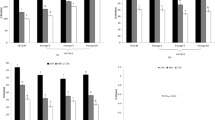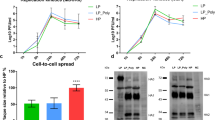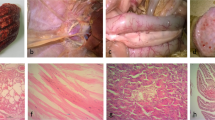Abstract
Newcastle disease (ND) is a highly contagious disease of poultry. The ND virus (NDV) encodes an error-prone RNA-dependent RNA polymerase which can cause high mutation rate leading to the emergence of its new antigenic variants. Antigenic difference of NDV strains may result in massive outbreak in vaccinated and unvaccinated poultry flocks around the globe. Apart from its pathogenic potential NDV has been explored as an oncolytic agent for a broad range of human cancers. In the present study, we isolated a novel NDV strain from an outbreak in chicken flock from the eastern part of India. Molecular characterization showed the NDV strain to be virulent in nature. The complete genome sequence analysis of the newly isolated strains belongs to genotype XIII. Moreover, the newly isolated strain of NDV showed positive results in various apoptotic assays in human breast cancer cells, MCF-7. The study will be useful to explore the possibility of using a newly isolated strain of NDV for virotherapy.
This is a preview of subscription content, access via your institution
Access options
Subscribe to this journal
Receive 12 print issues and online access
$259.00 per year
only $21.58 per issue
Buy this article
- Purchase on Springer Link
- Instant access to full article PDF
Prices may be subject to local taxes which are calculated during checkout





Similar content being viewed by others
Accession codes
References
Lamb R, Parks G Paramyxoviridae: the viruses and their replication. In: Knipe DM, Howley PM, Griffin DE, Lamb RA, Martin MA, Roizman B et al. (eds). Fields Virology. Lippincott Williams & Wilkins: Philadelphia, 2007, pp 1449–1496.
Peeters BP, de Leeuw OS, Koch G, Gielkens AL . Rescue of Newcastle disease virus from cloned cDNA: evidence that cleavability of the fusion protein is a major determinant for virulence. J Virol 1999; 73: 5001–5009.
Alexander DJ . Newcastle, disease: OIE Terrestrial Manual 2009. In: Manual of Diagnostic Tests and Vaccines for Terrestrial Animals 2009http://web.oie.int/eng/normes/MMANUAL/2008/pdf/2.03.14_NEWCASTLE_DIS.pdf.
Bogoyavlenskiy A, Berezin V, Prilipov A, Usachev E, Lyapina O, Korotetskiy I et al. Newcastle disease outbreaks in Kazakhstan and Kyrgyzstan during 1998, 2000, 2001, 2003, 2004, and 2005 were caused by viruses of the genotypes VIIb and VIId. Virus Genes 2009; 39: 94–101.
Kumar S . Newcastle disease virus outbreaks in India: time to revisit the vaccine type and strategies. Vaccine 2015; 33: 3268–3269.
Jakhesara SJ, Prasad VV, Pal JK, Jhala MK, Prajapati KS, Joshi CG . Pathotypic and sequence characterization of newcastle disease viruses from vaccinated chickens reveals circulation of genotype II, IV and XIII and in India. Transbound Emerg Dis 2014, doi:10.1111/tbed.12294; (in press).
Chong YL, Padhi A, Hudson PJ, Poss M . The effect of vaccination on the evolution and population dynamics of avian paramyxovirus-1. PLoS Pathog 2010; 6: e1000872.
Ji W, Niu DD, Si HL, Ding NZ, He CQ . Vaccination influences the evolution of classical swine fever virus. Infect Genet Evol 2014; 25: 69–77.
Gogoi P, Morla S, Kaore M, Kurkure NV, Kumar S . Complete genome sequence of a newcastle disease virus isolate from an outbreak in central India. Genome Announc 2015; 3: e01418-14.
Morla S, Kumar Tiwari A, Joshi V, Kumar S . Complete genome sequence of a newcastle disease virus isolate from an outbreak in northern India. Genome Announc 2014; 2: e00342-14.
Miller PJ, Haddas R, Simanov L, Lublin A, Rehmani SF, Wajid A et al. Identification of new sub-genotypes of virulent Newcastle disease virus with potential panzootic features. Infect Genet Evol 2015; 29: 216–229.
Liu XF, Wan HQ, Ni XX, Wu YT, Liu WB . Pathotypical and genotypical characterization of strains of Newcastle disease virus isolated from outbreaks in chicken and goose flocks in some regions of China during 1985-2001. Arch Virol 2003; 148: 1387–1403.
Zhao L, Liu H . Newcastle disease virus: a promising agent for tumour immunotherapy. Clin Exp Pharmacol Physiol 2012; 39: 725–730.
Lech PJ, Russell SJ . Use of attenuated paramyxoviruses for cancer therapy. Expert Rev Vaccines 2010; 9: 1275–1302.
Deyle DR, Escobar DZ, Peng KW, Babovic-Vuksanovic D . Oncolytic measles virus as a novel therapy for malignant peripheral nerve sheath tumors. Gene 2015; 565: 140–145.
Ulasov IV, Borovjagin AV, Schroeder BA, Baryshnikov AY . Oncolytic adenoviruses: a thorny path to glioma cure. Genes Dis 2014; 1: 214–226.
Kumru OS, Joshi SB, Thapa P, Pheasey N, Bullock PS, Bashiri H et al. Characterization of an oncolytic herpes simplex virus drug candidate. J Pharm Sci 2015; 104: 485–494.
Brown MC, Gromeier M . Cytotoxic and immunogenic mechanisms of recombinant oncolytic poliovirus. Curr Opin Virol 2015; 13: 81–85.
Liu TC, Hwang T, Park BH, Bell J, Kirn DH . The targeted oncolytic poxvirus JX-594 demonstrates antitumoral, antivascular, and anti-HBV activities in patients with hepatocellular carcinoma. Mol Ther 2008; 16: 1637–1642.
Cassel WA, Garrett RE . Newcastle disease virus as an antineoplastic agent. Cancer 1965; 18: 863–868.
Lam HY, Yeap SK, Rasoli M, Omar AR, Yusoff K, Suraini AA et al. Safety and clinical usage of newcastle disease virus in cancer therapy. J Biomed Biotechnol 2011; 2011: 718710.
Koks CA, Garg AD, Ehrhardt M, Riva M, Vandenberk L, Boon L et al. Newcastle disease virotherapy induces long-term survival and tumor-specific immune memory in orthotopic glioma through the induction of immunogenic cell death. Int J Cancer 2015; 136: E313–E325.
Fournier P, Arnold A, Wilden H, Schirrmacher V . Newcastle disease virus induces pro-inflammatory conditions and type I interferon for counter-acting Treg activity. Int J Oncol 2012; 40: 840–850.
Fabian Z, Torocsik B, Kiss K, Csatary LK, Bodey B, Tigyi J et al. Induction of apoptosis by a Newcastle disease virus vaccine (MTH-68/H) in PC12 rat phaeochromocytoma cells. Anticancer Res 2001; 21: 125–135.
Elankumaran S, Rockemann D, Samal SK . Newcastle disease virus exerts oncolysis by both intrinsic and extrinsic caspase-dependent pathways of cell death. J Virol 2006; 80: 7522–7534.
Kukhta VK, Marozkina NV, Sokolchik IG, Bogaturova EV . Molecular mechanisms of apoptosis. Ukr Biokhim Zh 2003; 75: 5–9.
Thornberry NA, Lazebnik Y . Caspases: enemies within. Science 1998; 281: 1312–1316.
Wyllie AH, Beattie GJ, Hargreaves AD . Chromatin changes in apoptosis. Histochem J 1981; 13: 681–692.
Zeng J, Fournier P, Schirrmacher V . Induction of interferon-alpha and tumor necrosis factor-related apoptosis-inducing ligand in human blood mononuclear cells by hemagglutinin-neuraminidase but not F protein of Newcastle disease virus. Virology 2002; 297: 19–30.
He D, Sun L, Li C, Hu N, Sheng Y, Chen Z et al. Anti-tumor effects of an oncolytic adenovirus expressing hemagglutinin-neuraminidase of Newcastle disease virus in vitro and in vivo. Viruses 2014; 6: 856–874.
Bai FL, Yu YH, Tian H, Ren GP, Wang H, Zhou B et al. Genetically engineered Newcastle disease virus expressing interleukin-2 and TNF-related apoptosis-inducing ligand for cancer therapy. Cancer Biol Ther 2014; 15: 1226–1238.
Fournier P, Aigner M, Schirrmacher V . Targeting of IL-2 and GM-CSF immunocytokines to a tumor vaccine leads to increased anti-tumor activity. Int J Oncol 2011; 38: 1719–1729.
Kumar S, Nayak B, Collins PL, Samal SK . Complete genome sequence of avian paramyxovirus type 3 reveals an unusually long trailer region. Virus Res 2008; 137: 189–197.
Cole SP . Rapid chemosensitivity testing of human lung tumor cells using the MTT assay. Cancer Chemother Pharmacol 1986; 17: 259–263.
Nicoletti I, Migliorati G, Pagliacci MC, Grignani F, Riccardi C . A rapid and simple method for measuring thymocyte apoptosis by propidium iodide staining and flow cytometry. J Immunol Methods 1991; 139: 271–279.
Ormerod MG . Investigating the relationship between the cell cycle and apoptosis using flow cytometry. J Immunol Methods 2002; 265: 73–80.
Linde AM, Munir M, Zohari S, Stahl K, Baule C, Renstrom L et al. Complete genome characterisation of a Newcastle disease virus isolated during an outbreak in Sweden in 1997. Virus Genes 2010; 41: 165–173.
Calain P, Roux L . The rule of six, a basic feature for efficient replication of Sendai virus defective interfering RNA. J Virol 1993; 67: 4822–4830.
Paldurai A, Xiao S, Kim SH, Kumar S, Nayak B, Samal S et al. Effects of naturally occurring six- and twelve-nucleotide inserts on Newcastle disease virus replication and pathogenesis. PLoS One 2014; 9: e103951.
Panda A, Huang Z, Elankumaran S, Rockemann DD, Samal SK . Role of fusion protein cleavage site in the virulence of Newcastle disease virus. Microb Pathog 2004; 36: 1–10.
Gogoi P, Ganar K, Kumar S . Avian paramyxovirus: a brief review. Transbound Emerg Dis 2015 doi:10.1111/tbed.12355; (in press).
Ganar K, Das M, Sinha S, Kumar S . Newcastle disease virus: current status and our understanding. Virus Res 2014; 184: 71–81.
Matassov D, Kagan T, Leblanc J, Sikorska M, Zakeri Z . Measurement of apoptosis by DNA fragmentation. Methods Mol Biol 2004; 282: 1–17.
Liu X, Li P, Widlak P, Zou H, Luo X, Garrard WT et al. The 40-kDa subunit of DNA fragmentation factor induces DNA fragmentation and chromatin condensation during apoptosis. Proc Natl Acad Sci USA 1998; 95: 8461–8466.
Fadok VA, Bratton DL, Frasch SC, Warner ML, Henson PM . The role of phosphatidylserine in recognition of apoptotic cells by phagocytes. Cell Death Differ 1998; 5: 551–562.
Peitsch MC, Polzar B, Stephan H, Crompton T, MacDonald HR, Mannherz HG et al. Characterization of the endogenous deoxyribonuclease involved in nuclear DNA degradation during apoptosis (programmed cell death). EMBO J 1993; 12: 371–377.
Cohen GM . Caspases: the executioners of apoptosis. Biochem J 1997; 326: 1–16.
Duriez PJ, Shah GM . Cleavage of poly(ADP-ribose) polymerase: a sensitive parameter to study cell death. Biochem Cell Biol 1997; 75: 337–349.
Espinoza LA, Smulson ME, Chen Z . Prolonged poly(ADP-ribose) polymerase-1 activity regulates JP-8-induced sustained cytokine expression in alveolar macrophages. Free Radic Biol Med 2007; 42: 1430–1440.
Wacker DA, Frizzell KM, Zhang T, Kraus WL . Regulation of chromatin structure and chromatin-dependent transcription by poly(ADP-ribose) polymerase-1: possible targets for drug-based therapies. Subcell Biochem 2007; 41: 45–69.
Zerfaoui M, Suzuki Y, Naura AS, Hans CP, Nichols C, Boulares AH . Nuclear translocation of p65 NF-kappaB is sufficient for VCAM-1, but not ICAM-1, expression in TNF-stimulated smooth muscle cells: differential requirement for PARP-1 expression and interaction. Cell Signal 2008; 20: 186–194.
Meng S, Bai H, Hu M, Liu W, Wang L, Wu Y et al. Mechanisms of in vitro anti-tumor effects of a Newcastle disease virus. Wei Sheng Wu Xue Bao 2009; 49: 512–517.
Walczak H, Krammer PH . The CD95 (APO-1/Fas) and the TRAIL (APO-2L) apoptosis systems. Exp Cell Res 2000; 256: 58–66.
Li P, Nijhawan D, Budihardjo I, Srinivasula SM, Ahmad M, Alnemri ES et al. Cytochrome c and dATP-dependent formation of Apaf-1/caspase-9 complex initiates an apoptotic protease cascade. Cell 1997; 91: 479–489.
Bian J, Wang K, Kong X, Liu H, Chen F, Hu M et al. Caspase- and p38-MAPK-dependent induction of apoptosis in A549 lung cancer cells by Newcastle disease virus. Arch Virol 2011; 156: 1335–1344.
Wei D, Yang B, Li YL, Xue CF, Chen ZN, Bian H . Characterization of the genome sequence of an oncolytic Newcastle disease virus strain Italien. Virus Res 2008; 135: 312–319.
Liu K, Ma Y, Wang J, Mu H, Gao C, Yang C et al. Complete genome sequencing and analysis of an anti-tumor Newcastle disease virus strain. Gene 2013; 525: 47–57.
Zamarin D, Vigil A, Kelly K, Garcia-Sastre A, Fong Y . Genetically engineered Newcastle disease virus for malignant melanoma therapy. Gene Ther 2009; 16: 796–804.
Schirrmacher V, Fournier P . Newcastle disease virus: a promising vector for viral therapy, immune therapy, and gene therapy of cancer. Methods Mol Biol 2009; 542: 565–605.
Acknowledgements
We thank Drs Sobhakant pathak and Shivanand Kanshi, IAHP, Kanke Ranchi for providing NDV outbreak samples. We thank Sudhir Morla and all our laboratory members for their excellent technical assistance and help. We are thankful to Dr Monika Koul for proof reading the manuscript. The NDV research in our laboratory is currently supported by the department of biotechnology (NER-BPMC/2013/134/AAB21), the department of science and technology (IFA-LSBM-34) and the board of research on nuclear sciences (2012/20/37B/06/BRNS).
Author information
Authors and Affiliations
Corresponding author
Ethics declarations
Competing interests
The authors declare no conflict of interest.
Rights and permissions
About this article
Cite this article
Kumar, U., Kumar, S. Molecular characterization of an apoptotic strain of Newcastle disease virus isolated from an outbreak in India. Cancer Gene Ther 22, 402–409 (2015). https://doi.org/10.1038/cgt.2015.35
Received:
Revised:
Accepted:
Published:
Issue Date:
DOI: https://doi.org/10.1038/cgt.2015.35
This article is cited by
-
Newcastle disease virus mediated apoptosis and migration inhibition of human oral cancer cells: A probable role of β-catenin and matrix metalloproteinase-7
Scientific Reports (2019)
-
Emergence of a deviating genotype VI pigeon paramyxovirus type-1 isolated from India
Archives of Virology (2017)
-
Evidence of independent evolution of genotype XIII Newcastle disease viruses in India
Archives of Virology (2017)
-
Evaluation of the oncolytic potential of R2B Mukteshwar vaccine strain of Newcastle disease virus (NDV) in a colon cancer cell line (SW-620)
Archives of Virology (2017)



